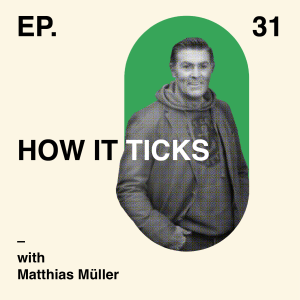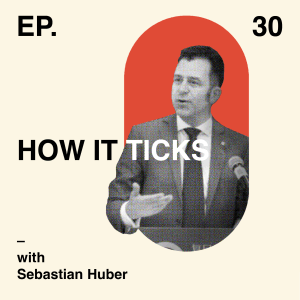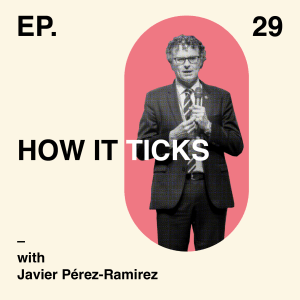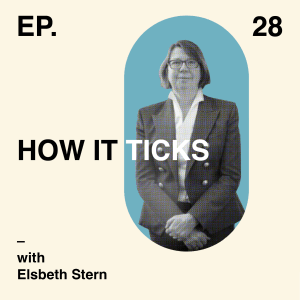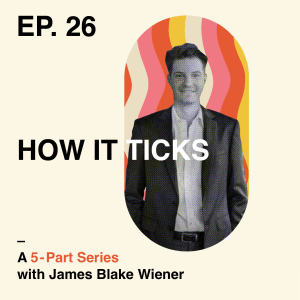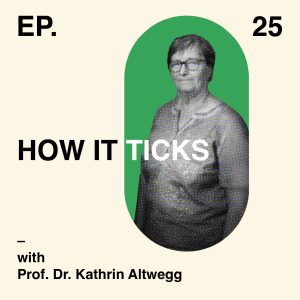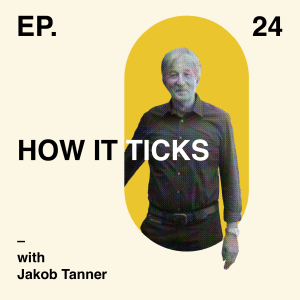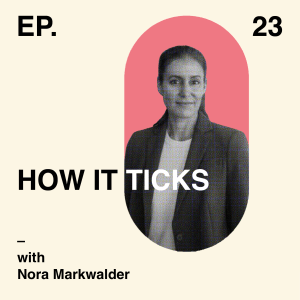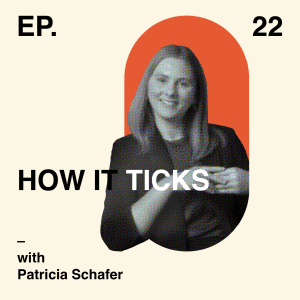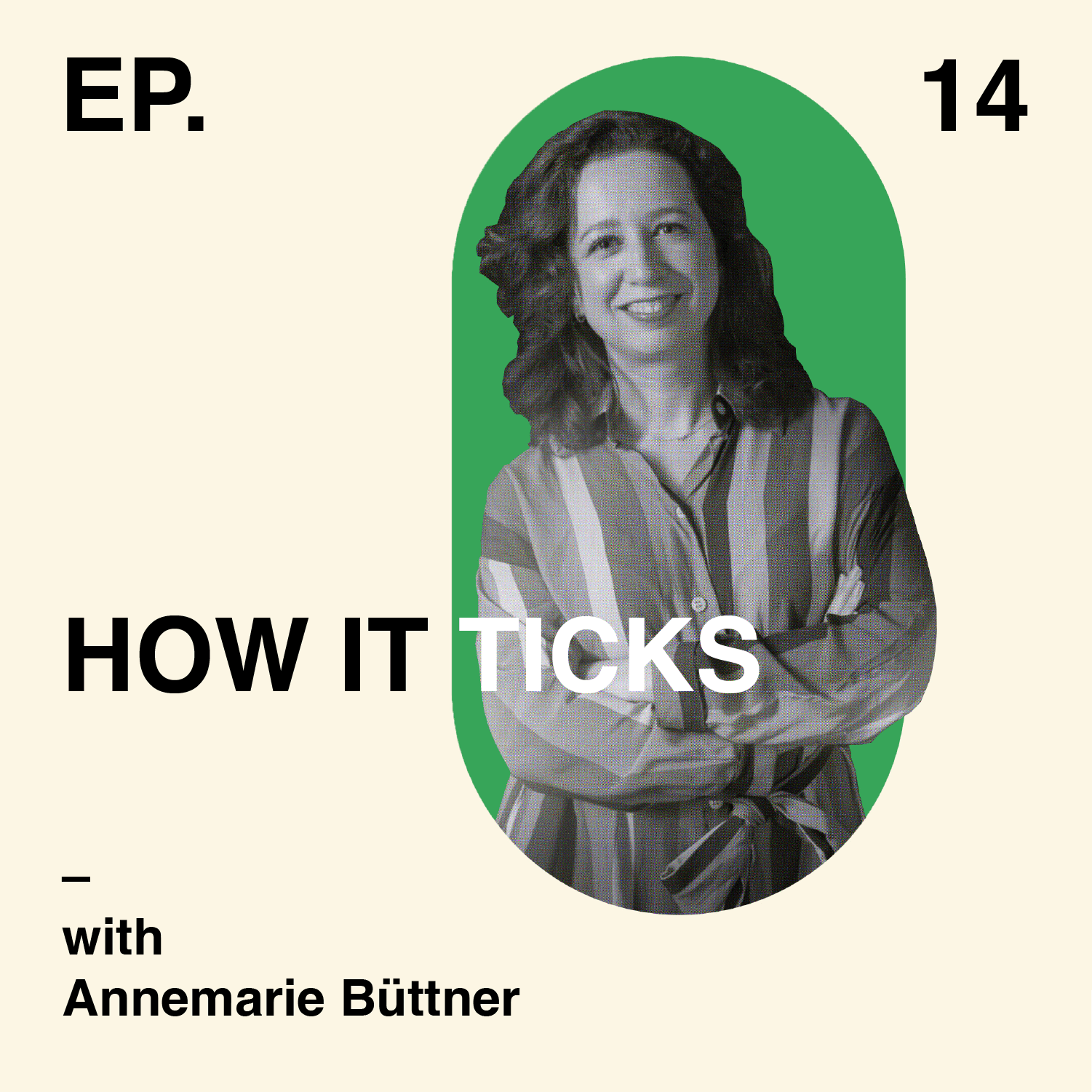
Understanding Climate Risk: Preparing for the Worst | Annemarie Büttner (#14)
Episode Summary
Annemarie Büttner, Lead of Climate Risk Solutions at Swiss Re, joins me to explore how businesses and communities can adapt to the growing threats of climate change. With her expertise in climate risk modeling and real-world case studies, Annemarie sheds light on the tangible impacts of climate risks and the strategies companies can adopt to build resilience.
Expect to learn how climate risk modelling works, the surprising ways natural disasters can ripple through global supply chains, and what steps companies and governments are taking to mitigate these risks. Annemarie also shares insights into how climate change is reshaping Switzerland’s urban planning and her advice for preparing for a more uncertain future.
Meet Annemarie Büttner
Annemarie Büttner is the Lead of Climate Risk Solutions at Swiss Re Corporate Solutions. She helps companies navigate the growing impacts of climate change by combining cutting-edge science with practical risk management strategies. Annemarie’s work focuses on identifying risks, designing solutions, and enabling businesses to build resilience in an uncertain world
Transcript
Mike: [00:00:00] Anne Marie, thank you so much for joining How It Ticks. How are you?
Annemarie: Hello, I’m great. Thanks for the invite Mike.
Mike: So lead climate risk solutions. That sounds interesting. And one of the reasons I wanted to talk to you today was because I wanted to understand more where Switzerland is at the moment regarding the climate and how they assess climate risk.
But before going there, can you maybe explain to me a bit about Okay, great. Thanks. What your industry is and how you got to where you are.
Annemarie: Yes. I’m very happy to. So, um, my background is environmental engineering. And so when I, when I studied at the technical university in Munich, I thought what would be most interesting in this whole climate, or yeah, natural.
Space environmental space and I came to natural catastrophes. I found that incredibly interesting. Like how nature hits back on us. Um, it’s the most unexpected times. And so example, how we are impacting [00:01:00] our daily lives with, um, floodings or with storms. Storms or this really big events that are really shaking us up.
So, um, that’s how I decided to go into it, go into the industry and become a natural catastrophe, uh, modeler at the time. So I work in the insurance and reinsurance industry, , throughout, throughout my career so far, and we are looking at the big events that are really shaking up societies. And with climate change, we’re seeing that events have shifted.
So storm patterns have. But are starting to shift flood patterns, maybe intensifying in some areas of the world we see new or more, coming perils like, um, droughts. And I really wanted to study that better and understand, uh, what journey we’re on to where we’re up to going forward. So what I do is I work with corporates all around the globe and help them to understand what climate risk means to them in terms of physical impacts, so how they will be [00:02:00] impacted by more floods, more storms, droughts, supply chain interruptions, and so on.
And just to give you an example of a headline that we recently had in our Swiss News, there is this, train manufacturing company called Stadler. And, their, share value has really plunged because of the climate risk event. So there was a major flood in Spain, um, their own facilities, got flooded, but especially their, uh, suppliers got flooded.
And so they really have a supply chain interruption and, um, have major impacts into their whole, uh, into their whole business. So these are the events and these are the same things we’re looking at.
Mike: How much do companies need to do this and feel like they have to because every company has to care about the climate now? And how much of it is them being aware enough to go, this is really important for us to do because if we, if we miss something, it could be a catastrophe.
Annemarie: [00:03:00] So there’s very different clients some are really well prepared and some are completely surprised when we talk to them about these natural catastrophes And how they could be impacted Um, so it really depends on who you speak to within a company And there are some regulations like the eu taxonomy that have really um that are a framework where a client where Corporates have to think about their climate risk.
They have to report them. They have to get an understanding about where they’re exposed. And this is a really good, um, opener, first step for for corporates to get acquainted with the climate risks that they are, that they are facing. So this is a good way to start the assessment. But of course the regulation is only the first step.
In the end what we really need to do is adapt to the new normal of climate risks.
Mike: So this is climate risk in the sense that the impact the climate can have on companies, not the impact companies can [00:04:00] have on the climate.
Annemarie: Exactly. You’re just explaining the double materiality and what I’m looking at is how climate change will impact the business and the operations of a company.
So, um, yes. How, how the climate is impacting us and not how we are impacting the climate.
Mike: Interesting. Can you. Explain a bit the process of how you would go about modeling climate risk. I mean, it makes sense in a very high level, but I’m curious what that actually looks like, uh, when you do the actual work.
Annemarie: Absolutely. So, um, I would start with, uh, I would start with natural catastrophe modeling. So this is really the, the catastrophes, um, like the flooding events, the storm events, the earthquakes that we’re having at the moment, while, um, little, um, yeah. In brackets, earthquakes are not impacted by climate change.
We’re looking at the other ones. But in natural catastrophe modeling, we’re looking at all these events. We look at where do we have [00:05:00] assets all around the globe. We look at the different intensities and frequencies of these events all around. The globe, we tie a vulnerability to it. So for example, um, an office building that is 10 stories high is less vulnerable to flooding than like a storage facility, which is only like one floor and nothing is lifted, for example.
So we tie different vulnerabilities to it. Um, and then we run a financial model and calculate out of that out of this, um, has it, um, vulnerability and the exposure. And then we calculate together out of these three, um, really the financial impact. And from that, we derive also an insurance premium, for example, like very simply explained.
But this is only the current risk with the natural catastrophe month that we have so far. We’re very much looking at the past So how many losses did we have in the past this? Um, and that [00:06:00] should tell us what the future is going to be but now we get climate change really Impacting the different flood and storm patterns, for example, and so we have to rethink this process and for that we take, climate models that are representing, um, how the future should look like.
To simply explain it, we’re looking at different, um, future trajectories and Try and understand how the, how the precipitation patterns will be in 2030, 2050, and we put them on top of our current risk natural catastrophe models.
And from that, we get an idea like, will your flood risk cost you in the future, um, 20 percent more or 50 percent more, um, depending on the climate change scenario, um, that we think we are on. Yeah. So, so that’s how it works. We got the current risk. We put a future view on it based on different, for example, precipitation patterns.
Mike: So you can go as far as 20 or [00:07:00] 30 years into the future. What degrees of certainty do you have as the time gets further and further out?
Annemarie: Yes. The CMIP6 models go until 2100, um, yeah, 2100. We use a 30 year moving average. So the last, uh, the last, or the longest we look at is 2085.
Yes, but of course, the uncertainties increase with how long we will look into the future, and we don’t have a crystal ball, but what we offer our clients to understand, or really try to understand with them, is which trajectory are we going towards. So what is the general direction of, for example, these precipitation patterns?
But, There is various, um, limitations and uncertainties that are challenging the data and the field in general. So, um, for example, on the globe where we would like to have perfect [00:08:00] global coverage, the truth is a bit, the reality is a bit different. So we have sometimes a bit better, better coverage, for example, the U.
S. or in Europe, but, um, a global coverage is really something that we, they were really, um, that we really thrived or would like to have. Um in a good granularity But also we have to be very transparent with with the our clients are the people we talk to about climate risks about the Uncertainties and of course people would like to have like one number This is going to be my future risk But we also have to get some understanding for these uncertainties because in the end we also don’t have a crystal ball But we’re trying to work with the best data possible, To have an understanding about how the future would look like.
Mike: How susceptible are companies to, or how open are they? And I guess this would not be a one size fits all, but how open are they to taking the advice or the recommendation from you, [00:09:00] especially when you’re predicting that in 10 years time, where they’re planning on building is not going to be beneficial to them.
But as of today, it seems fine. How much pushback do you get?
Annemarie: So of course we get challenged. Of course the clients then will, the corporates then will tell us, we haven’t had a event in 50 years. Why do you think this is an issue now? And all we can tell them is our models show it’s an issue.
If you cannot prove to me that you did some, let’s say flood protection or Adaptations and measures. Um, then we believe this is the risk. And I think with climate risks and the events that we have more and more frequently in the news, this is helping us a lot to say, Okay, you haven’t had an event in the past, but look, these other companies didn’t either.
And now they’re surprised. And now they have issues with their supply chain. They have issues to keep their supply chain. Okay. Assembly lines running, so it [00:10:00] would be much smarter to consider and invest in preventive measures than, um, then to take up the insurance and probably also a good way to start the conversation is, um, insurance prices will potentially adapt to, um, how climate change is, impacting the natural catastrophe.
So better, better consider preparing, ahead of before that really happens.
Mike: So when you do your risk analysis and you present your customers or your clients with the results, what does that, what does the results look like? Uh, I’m guessing then based on what you’ve said, you’re not giving them a concrete number, you’re going to give them a spread of different options, each with tied to a different likelihood or something like that.
Annemarie: So we are giving them an exact number. So we’re giving them, for example, an annual expected loss in 2030 or in 2050 for let’s say your flood risk, your annual [00:11:00] expected loss, which is the. Average of all the events that you may have over a long period of time, so that would be a bit similar to your technical premium that you would pay to for, uh, as an insurance.
So your annual expected loss, let’s say today for this specific site that’s in a flood zone today. It’s 10, um, 10 million. But in the future, it may be, um, it may be 12, 15, 18, depending on the different climate change scenario. So that is the difference. So we’re giving the clients different.
Climate change scenarios. We’re working with the S. S. P. Um, scenarios. S. S. P. One is a scenario that says, okay, we’re gonna, um, decrease our emissions. We’re gonna achieve the agreements of the Paris climate. Agreements. So we’re really gonna significantly reduce, as a global society, our emissions. SSP2 is a middle of the road scenario.[00:12:00]
We’re not gonna achieve 20, uh, net zero by 2050, but we’ll have that a bit delayed, and then, uh, we’re still on a trajectory towards Reducing our emissions. And then we have SSP 5, which is a bit like the worst case scenario. We’re not reducing our emissions, but keep on emitting, keep on using oil and gas.
And that is typically the worst case assessment. And then you get different, different annual expected losses, as I said. So let’s say currently 10 million, um, under SSP 1 in 2030, you’ll have 12 million. And you’ll expect it lost under SSP 2, you’ll have 13 under SSP 5, you’ll have 15 million. So you can really see that your difference, in how, how we are as a global society emitting is really then a difference on your balance sheet of how much you’ll have to pay for your insurance to still be flood protected.
Because for example, under SSP 5, we’re expecting a lot more extreme precipitation compared to SSP 1.
Mike: [00:13:00] So once you’ve actually identified a risk and you’ve given this information to a company and they take that on board, what do you give them as actions to do?
Annemarie: So I think really the magic happens less in the assessment and more when you translate it into actions and really adapt, to the, Changed risk landscape. And so we have these risk engineers that I mentioned. So these potentially rubber boots on the ground that we can send all across the globe.
They look at the site and then make an assessment about really what would be the impact in case, um Yeah. A flood event would happen, a storm would happen, a drought event would happen, or a heat wave would happen. What would be the impact for, for your business, at that specific site? And then we sit down, actually a climate risk expert sits down with a risk engineer that has, that knows everything about the site, has proper [00:14:00] Potentially been there.
And then we brainstorm really about how you can, um, what would be a next steps if we would own that company? What would we do next? Would we, for example, develop a flood emergency response plan? So in case of a flood warning, you could just get that plan on your desk and then everybody would know what to do, or we would recommend them to build, to build a flood wall, or we would recommend them, for let’s say heat waves, which we haven’t talked about yet.
So for heat waves, for example, check if your cooling systems are adequate. So in case you’re producing. for example, the cool chain can never be interrupted. So you really need to make sure in case in the future, extreme temperatures can reach, uh, five degrees more than you’re used to.
So is your cooling system still stable at that point, or do you need different insulation to really withstand there. Do you potentially need some auxiliary power for you? [00:15:00] Heating, cooling, ventilation whatsoever. Then we would come up really with a list of next steps. What can you do to to manage that risk?
And we shared that with the corporates and, cross our fingers that some of that gets implemented.
Mike: One thing I probably should have asked you about when we first started this conversation is What is the scope?
What are the different environmental catastrophes , you mentioned storms, you mentioned flooding, what else, what are the big ones that we should probably define up front before giving these details?
Annemarie: Yeah, I think drought, um, drought, heatwave, wildfire, so the whole, Yeah, the whole water topic will be extremely, relevant for us in the future.
A lot of our clients, so a lot of corporates are using a lot of water for their, um, for producing their goods. And so this will be a topic that’s going to be very high on the agenda going forward, in my opinion. But, yeah, [00:16:00] so we’ll look at precipitation related, um, related events, storm related events, sea level rise, um, yeah, drought, wildfire, um, and these, uh, and these things, and also landslides, for example, yeah, also tied to extreme precipitation because that increases the probability of landslides, for example, so it’s all inter, it’s all interconnected, but it’s basically water related, landmass related, um, wind related, um, and temperature related,
Mike: perils. Can you just define, what is extreme precipitation?
Annemarie: So when it’s raining really, really heavily, not over a long period of time, not over several days, but within several hours, let’s say a lot of precipitation is coming down.
And that means that water doesn’t have time to flow into the rivers. But you can basically have a flood away from the [00:17:00] river, so you can have a flash flooding event anywhere around as well. And that’s the difference between like a fluvial flood, which is like the river is getting too big and is flooding the areas around it, and a pluvial flood event, which is flash flooding, which can be, can occur anywhere because of extreme precipitation.
Mike: Out of all of these different areas of focus, which ones impact Switzerland?
Annemarie: Yeah, when I think of Switzerland, um, I firstly think of the glaciers. Um, because this is something, where we’re mostly impacted, um, here. And, um, I just listened to, uh, to talk of Professor M a month ago and he said the, The really water in heavy years, so where we still have enough water.
They are now because now the glaciers are melting Um, but we’ll really have more drought and have First less water rich years in the future and we’re [00:18:00] gonna we’re gonna impact be impacted by that So when I think of switzerland, I think of the glaciers then also. Landslides. Um, as we’re currently, for example, having, um, having a mountain village in Brienz, um, evacuating because of this major, landslide.
Also, these things may be intensifying with climate change. And in Switzerland, I also think of the ski industry, for example. Like the ski seasons are changing. Uh, the last years have not had very good snow. Um, and you have to work a lot with artificial snow. So we’re also impacted our daily lives, with climate risks.
Mike: What’s um, do you have any interesting examples of a climate risk assessment that you’ve done recently for a Swiss company or a Swiss government?
Annemarie: Absolutely. So we work, uh, we work with various, uh, with various different companies all around the globe. And, one of the good examples, it’s not a Swiss [00:19:00] company, but it’s operating all around the globe. Um, it’s, Copenhagen infrastructure partners. They are renewable energy, investor. So they’re having projects all across the globe with solar projects, uh, wind projects, and we’re working together on making their, like, investments, , future proof.
So we’re making sure that you’re building a new, , wind farm, with, , Keeping in mind how the wind patterns may change, how the different risks will shift. So we’re making sure that their investment is really good investment in the very long run as well. So they’re prepared for this. Another, uh, another example for, for a company that we recently worked with is, uh, Laptalis Nestle.
they’re. Producing yogurts and mozzarella. So anybody in Switzerland has probably eaten some of their products already, and they’re also, they’re needing a lot of water to produce the food that we’re eating. So they need to make sure at their production sites [00:20:00] that they still will be enough fresh water in a good quality so they can be sure that that they can produce the goods that we need for our daily lives.
And a third quick example that we’re currently working on is a pulp and paper company in Asia. Also here, probably everybody has received a package wrapped in their pulp and paper wrapped in their cartons in the last months, and with them, we’re looking at wildfires and flooding of their paper mills and so various different risks also in Asia.
And, this is an interesting one Because we think it’s, it’s so far away, but in the end, our global supply chains will make this, this very real, um, also for us in Switzerland, when these, uh, these companies, are struggling with climate risks.
Mike: Maybe you are, maybe you aren’t allowed to share, but what is the process?
They are [00:21:00] building a new factory somewhere in Asia, because that’s the most appropriate place for paper. They go, Hey, we want to first make sure that this is environmentally appropriate to build here. They get in contact with you and the assessment, like what data do you look at? I mean, I know you said you take historical data, but what specifically are the data points?
Annemarie: Yeah. So, so what we would get from the, from, the corporates we work with is where’s your site, where’s your location, what are you planning to do? So what occupancy types? So, so what are you actually planning to build there? And then we would run our models that, uh, that we use also for our insurance pricing.
We would run our models and, get then like the risk landscape for that specific location. So you can imagine it like, like you’re on Google Maps and you want to map your house and have like a polygon of, um, not just a pin, but really an area. So there, this is my house. This is my area. I want to know how this is impacted.
Yes. So then we’re running these [00:22:00] models and we’re getting out the, let’s say a risk landscape for that specific site. And, then we’re looking at it together with a risk engineer. We have, um, about 200 risk engineers in our team in Corso, um, of Swiss Re. And, so there’s specialists for various different industries.
And they will then tell you, um, on one hand side, How these climate risks are really impacting that side. So as I said again before, this is a flash flooding site. But is this at all relevant if if we’re looking at a forest? Okay, it’s flooded. Then it’s no more flooded. The trees don’t mind. Is it manufacturing side?
We really care. So we’re looking then at the vulnerabilities and the impacts together with the risk engineer, and then we write up a really tangible next steps so actionable items that, um, that we think should be implemented to manage that risk. The risk engineer can go on site as well and then we’ll find some other items.
Then we’re coming up with a [00:23:00] risk with a list of risk improvements. And that could be. For example, a recommendation to build a flood wall, a recommendation to move your, um, emergency electricity from the basement to the top floor because that’s what flooding would go first. So that’s where the water would go first.
So we’re then having really a list of recommendations. On what they could implement in their site, which they were planning on building or have already built And uh, we’ll wrap that all in a nice report and then they can work On it. They can also share that report with their investors.
They would be really interested the investors to know is that Investment that I’m making is that resilient or is that going to be impacted in the future? Um, so yeah, this is then very relevant information for the different departments within the company also the sustainability teams Um the insurance teams the local risk managers [00:24:00] and so on
Mike: how often do you see the results of your work? So either a company has? taken your recommendation and you can see somewhere, Oh, look, this has actually done something or conversely, they haven’t taken your recommendation and they’re now suffering with the consequences.
Annemarie: Of course, we see both, but these processes take time and our platform for the, for the clients to look at data, that exists in three years.
So it’s really cool platform where you upload your locations and with a click of a button, you get a report on your risks back current and future risk, including the financial impacts. I have to say we are a starting point. Also our recommendations. They’re a starting point. And then you have to make an investment case.
And then you have to build that flood wall, for example. So this is a process and we’re like kicking off that process for many, for many corporates. And yes, we do see some, some [00:25:00] results out of it. So once we did, um, for an IT company, an assessment of their different, their different offices, and they were thinking of which office they should move.
And, the one we flagged with the highest risk was in the end the, the one where they decided to move. So really our assessments went into that board decision making process. Because if you have your, server racks there in the basement, that’s probably a bad idea. So, yes, there is really tangible outcomes, and these information, go into, decision making also at the boards.
Mike: Do you see a big variety with all of the different countries or the companies in different countries that you work with? Do you see a big difference in appetite for risk. I mean, I can only imagine the Swiss are the most conservative when it comes to
Annemarie: Absolutely. And one would think so, but I don’t always see that.
[00:26:00] So I just have to say, I think the Asians are doing a really good job at Thinking ahead, um, and it really preparing. I think also they have been the most impacted in the past. So they are really sensitive and towards that topic , the europeans I have to say we’re we like being guided by regulation and so the eu taxonomy is As a good starting point, but we have to be careful to not Use the use these regulations to produce paper, but to really learn something from it and really then do the next steps and translate it into actions.
in the US, uh, we have been waiting for regulations, but with the, with the recent, um, shifts in politics, I don’t think that the regulations will come. So I find that very, very unfortunate because especially in the US, they are so heavily impacted. In Florida, um, with with hurricanes in California with drought and wildfires.
So I think [00:27:00] that would be very beneficial for them to, um, to in a more structured way to start thinking about their climate risks than they do at the moment. But I feel like they’re they’re still like waiting for the regulation. So let’s see. So very different approaches around the globe. But, I really hope that we’re, that the interest will further rise and not only with, with new events and scary messages in newspapers, but really from an intrinsic wish to, uh, to make, um, operations more resilient.
That’s
Mike: actually an interesting point. From the data that you see, how big is the threat versus the News that the consumer gets I guess you’re in a unique position where you get to actually see data driven outcomes of the last X amount of years.
So what is for you the difference between what you’re actually seeing versus what you’re hearing in the media and the news?
Annemarie: Well, how it really depends on what media news you’re [00:28:00] consuming. But, I have to say the, the world will go on and, uh, we will have a lot of local events. what I see as the biggest issue, on a global scale is the whole water topic we’re in a very water rich location in Switzerland, so very privileged position, but many other, many other countries, like even areas of Germany, will have further impacts or will experience, droughts.
And, I come from a little farm, uh, in Franconia in, in Germany. And, We are last two years, so we have experienced drought, like drought on our fields that have been really unprecedented, like my grandmother has never seen before. I think, the differences will be. The global differences, um, will increase further and I think this water topic, this is something that [00:29:00] is really going to impact us all around the globe and, um, where we will have to prepare, prepare better in the future.
So that would be my, if I have to single something out, it’s less these, um, yeah, individual events, but more like the global, um, chronic, global events. Yeah, issue of drought and water scarcity.
Mike: And that really comes down to the fact that it’s just raining less than it used to?
Annemarie: So we have more extreme precipitation.
We have more prolonged durations of, of no precipitation. And also that depends on where you are on the globe. But, um, in general, I think it’s fair to say that the extremes will become more extreme regarding precipitation and what we would actually need was more like a stable, yeah, stable precipitation patterns and that will, that will shift.
So the groundwater levels will fluctuate more than we used to have that in the past. [00:30:00]
Mike: I, I, I often wonder how much repetition or how much change do you see before you decide that this is due to, a changing climate? So if we have, yeah, three very warm summers in a row.
There’s a percentage of chance that this is just a particular, happened to have three warm summons in a row. There’s nothing. It’s weather. It’s weather. It’s weather. At what point do you look at patents and go, no, this is actually a bigger change and not just the weather changing from year to year?
Annemarie: So we really have to differentiate between weather and climate.
So weather is what we’re, what we’re seeing when we look out of the window. That’s the current weather. What we have this year is weather. But if we look at, if we accumulate, or if we look at the averages of weather over 30 years, Then we speak of climate. So, the climate of 2024, what we’re having at the moment, we will only know in [00:31:00] 15 years time when we really know what happened 15 years before and after, so we can create an average over these 30 years.
So, but what we can see is that these 30 year moving averages, that they’re really Shifting that we see increased temperatures like if you look at the global average temperature year by year, and you really see that every year we’re having we’re having pretty much another peak, and there’s really a trajectory across, temperature statistics.
So at this point, I find it really hard to be a climate denier when you have so many evidence points since I’m sorry, so many years as well. Um, so yeah, just look at the, just look at the temperature statistics and um, then you’ll hopefully be cured.
Mike: Are you optimistic about the future? You deal with risk and you see a lot of, um, the data, seeing what’s to come and seeing how the world [00:32:00] is preparing for it.
Does it make you, does it make you sleep well at night or does it keep you up?
Annemarie: I am a very optimistic person by my personality. But, um, I have to say that that sometimes I’m questioning the intelligence of the human race when it comes to when it comes to these um so of course I sleep well at night because there’s only so much I can do but I can try and uh, try and talk to corporates and boards about the really, importance of, um, of climate change.
For example, I was speaking to really a board of directors, um, of a, of a global oil and gas company and told them about climate risks and they were very, uh, very responsive to it. And we’re like, okay, yes, we’re aware of this. So let us try to work on this, but also we’re waiting for regulation.
So I would say that [00:33:00] it’s a bit of chicken and egg question that, I really hope that Politics will, will put the right regulations in place because I, I also think that, that that would make all the differences, um, and then companies would, uh, react accordingly, reduce their emissions and prepare better.
So this is, um, this is where I, I think, um, a lot of things will need to happen, but in the end, the sun will rise in the East and set in the West. And, let’s see how this goes. We’re only. We’re only here so many years.
Mike: How has your line of work impacted your personal life and the decisions that you make?
Annemarie: Oh, we have recently bought a house and I definitely made an assessment. So we’re in a 500 year return period flood zone. So there’s a very small chance of being, uh, of being impacted by flooding. But, I think for me, it, it was very helpful to understand also how [00:34:00] corporates think , about climate risk and how they, Really want to become more resilient.
And I think everybody should kind of have that mindset of, preparing for the future and, uh, and managing these risks. Um, yeah.
Mike: You said water was one of the biggest potential catastrophic things to pay attention to and to be concerned about, but Switzerland is very water rich.
What specifically is the biggest, potential Catastrophic event, which could impact Switzerland.
Annemarie: Many people are not aware that, Parts of Switzerland are also an earthquake, uh, An earthquake region, so that would be Something, something to consider. But, for example, Zurich, the city of Zurich, in 2005, had almost a pretty big flood event, and, it was at the [00:35:00] brink, so nothing happened, but, the Seele, which is a river, in Zurich was really to its limits and at the, at the main station where the seal is channeled, um, then into, into the limit, , that’s the narrowest part of it.
So this almost flood event really. Yeah, really triggered something really very good. So then, now, the city or the canton has built a channel for water from the seal to Lake Zurich. That is before the water reaches the city. The channel would, um, Yeah, take the water from the seal and put it directly into Lake Zurich.
And that would, yeah, reduce the amount of water that would have to go through the main station. So these kind of projects then that will make the city a lot more flood resilient. Because we learned from this almost event. So this is, this is a [00:36:00] perfect example of how we should, um, how we should prepare also for climate risks and more extreme, extreme precipitation events, to have these structures now in place.
And it was a major project. It was, 170 million or something. Please don’t quote me on that one, but it was a, a major investment for the canton, but imagine the whole city of Zurich being underwater, the loss of property and also business interruption, impact on people’s lives and people’s savings, that would be devastating.
So there’s a very good example of how we in Switzerland are preparing for such impacts.
Mike: That’s nice to hear. In general is the. From what you’ve seen, the Swiss government quite responsive and responsible when it comes to environmental protection.
Annemarie: Oh, I don’t want to, I don’t want to give judgment on that, but probably compared to other countries on the globe, of course, we got the resources to be prepared.
So who, if not us, [00:37:00] my thoughts are going more towards. More vulnerable, regions in the global south, especially that don’t have the awareness of the protection or the governmental support in case of an event. So, uh, we saw some years ago that, Pakistan had major flood events and that was really extremely devastating to the people there.
So I believe with climate risk. Um, again, we in Switzerland, we can prepare very well. We’re thinking ahead. We got the models, but it’s also very important to support, other countries in, uh, in preparing, for example, future drought events. Trying to, limit the spread of the Sahara so of, of deserts and, um, trying to share more, knowledge about water recycling and so on. So, um, yeah, my looks regarding these go more towards, uh, towards the Global South.
Mike: You said, you said limit the spread [00:38:00] of the Sahara. What do you mean by that? The Sahara is getting bigger.
Annemarie: It is indeed. It is indeed. So there are several projects that, uh, that are trying to, Build more vegetation, especially at the South.
So it’s spreading further to the South, the Sahara is getting bigger at this point. It’s growing.
Mike: We haven’t talked so much about heat. How does, I wonder this, how does a heatwave negatively impact a city or a company?
Annemarie: In the recent years, so we’ve been through some heatwaves in Switzerland.
And, I think everybody feels that productivity is going down when it’s just 35 degrees outside, and also health impacts. So if you’re, for example, if you’re on a construction site, you’ll probably need to pause, building or you need to, um, Yeah, install additional ventilation for your workers, give them additional water breaks and so on.
But [00:39:00] also as a society, mortality rates are impacted by heat waves, for example. For elderly people, heat waves are more or harder to bear than for young and healthy people. So yes, it impacts us in different ways. And for example, the city of Singapore is a very good, very good example. They have built A lot of art.
They have planted a lot of green spaces and really reduce the temperature in the city. And, yeah, made it just a much more livable place, even during very warm periods. And I think this is something we need to learn. Also in Switzerland have less of these concrete sealed, spaces that will be so hot when you walk over it, but more green spaces.
That will also really reduce the temperature in the cities. So I think the whole city planning, needs to be aware of heat waves and, and heat related, um, issues, health issues in the future. [00:40:00] So yes, on one hand, corporates, productivity, workers health, but on the other hand, really also city planning.
Mike: Yeah, I do understand that. I mean, I’m from Australia, it’s very hot, but also the buildings are built differently. Um, and here the buildings are built to keep the heat in because of the cold weather. Yes. If you get something above 30 degrees, it is a difficult place to be in, uh, in a, in a small apartment.
Yeah, I don’t know what the solution to that is a practical one. It’s a big investment to find a way to make buildings cooler for everybody.
Annemarie: Yeah, and in my opinion, the solution should not be everybody gets air conditioned. I, I would really like to not live in a world where I have to be in a, in a concealed space all the time and cannot just open my window.
That’s really not the vision I have for the future. So. Yes, let’s hope greenery and, uh, more green spaces and, [00:41:00] um, fountains will be the better solution than everybody locking themselves in with air conditioning.
Mike: Now, I have one final question for you if there is one or two things which you would, uh, advice or wisdom which you could give to the listeners, which you gather by the job that you do.
What would that be? Something which the average person walking on their way to work right now can think about, insights which you’ve gained specifically from your line of work?
Annemarie: Just start thinking of, of climate change as not as something that is coming back to us. Um, something that we’re causing, but then it’s really also coming back to us. So it will impact us. The impacts are already there. so I think it’s really in our hand to decide which climate change scenario, we will be on.
And then also, not to scare anybody, but, um, let’s try and just mentally prepare. [00:42:00] We’re probably going to live in a bit of a different climate. And, it’s, uh, it’s on us to shape that right now by, for example, voting or, for example, yeah, taking the train, um, in this excellent train system that we have in Switzerland.
I would say it’s it’s a gorgeous world we live in. Let’s try. Let’s try and keep it as cool as it is.
Mike: Maybe do your research before buying a house on the beach or next to a river.
Annemarie: Oh, yes. And they’re 100%. So, so don’t get. Get scammed by, by not understanding what, what you’re, what you’re getting.
And as a corporate to really think about your processes and, uh, think about, um, how climate risk may impact you beyond, uh, beyond just the typical ones like flooding and storm, but really also heat and drought.
Mike: Anne Marie, this has been a very insightful conversation. Thank you very much for your time.Annemarie: [00:43:00] Thank you so much for having me, Mike. It was an amazing time. Thank you.

